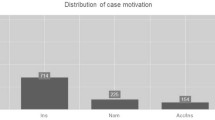Abstract
The primary goal of the present study is to find an adequate method for the quantitative analysis of empirical data obtained from parallel corpora. Such a task is particularly important in the case of fixed constructions possessing some degree of idiomaticity and language specificity. Our data consist of the Russian construction дeлo в тoм, чтo and its parallels in English, German and Swedish. This construction, which appears to present no difficulty for translation into other languages, is in fact, language-specific when compared with other languages. It displays a large number of different parallels (translation equivalents) in other languages, and possesses a complex semantic structure. The configuration of semantic elements comprising the content plane of this construction is unique. The empirical data have been collected from the corpus query system Sketch Engine, subcorpus OPUS2 Russian, and the Russian National Corpus (RNC). We propose to use the Herfindahl index as a tool for quantitative analysis in order to measure the degree of uniformity in the frequency distribution of the various translations of the construction under investigation. This tool is not universal and does not enable us to answer all the questions that arise in connection with determining the specificity of language units. However, it clearly helps to obtain more objective results and to refine the quantitative analysis of idiomatic constructions on the basis of corpus data.
This paper is based on work supported by the Russian Science Foundation (RSF) under Grant 16-48-03006 “Semantic Analysis of Translated Texts for Comparative Cultural Studies and Cultural Specificity in Language Learning”.
Access this chapter
Tax calculation will be finalised at checkout
Purchases are for personal use only
Similar content being viewed by others
Notes
- 1.
Literally: the thing is that.
- 2.
Literally: the problem is that and the truth is that.
- 3.
For more detail see Sitchinava (2016).
- 4.
- 5.
Figures in brackets indicate total number of hits.
References
Buntman, N.V., Zaliznjak, A.A., Zatsman, I.M., Kruzhkov, M.G., Loshchilova, E.J., Sitchinava, D.V.: Informacionnye texnologii korpusnyx issledovanij: principy postroenija kross-lingvističeskix baz dannyx (Informational technology in corpus-based studies: towards a cross-linguistic database). Inf. Appl. 8(2), 98–110 (2014)
Dobrovol’skij, D., Pöppel, L.: Diskursivnaja konstrukcija N в тoм, чтo i ee paralleli v drugix jazykax: kontrastivnoe korpusnoe issledovanie. (The discursive construction N в тoм, чтo and and its correlates in other languages: A contrastive corpus analysis). Novosibirsk State Pedagogical Univ. Bull. 6, 164–175 (2016a)
Dobrovol’skij, D.O., Pöppel, L.: The discursive construction дeлo в тoм, чтo and its parallels in other languages: A contrastive corpus study. In: Computational Linguistics and Intellectual Technologies: Papers from the Annual International Conference “Dialogue 2016”, issue 15 (22), pp. 126–137. RGGU, Moscow (2016b)
Günthner, S.: Die “die Sache/das Ding ist”-Konstruktion im gesprochenen Deutsch – eine interaktionale Perspektive auf Konstruktionen im Gebrauch. In: Stefanowitsch, A., Fischer, K. (eds.), Konstruktionsgrammatik II. Von der Konstruktion zur Grammatik, pp. 157–177. Tübingen, Stauffenburg (2008)
Sitchinava, D.: Parallel corpora as a source of defining language-specific lexical items. In: Margalitadze, T., Meladze, G. (eds.) Proceedings of the XVII EURALEX International Congress: Lexicography and Linguistic Diversity, pp. 394–401. Ivane Javakhishvili Tbilisi University Press, Tbilisi (2016)
Šmelev, A.D.: Russkaja jazykovaja model’ mira. Materialy k slovarju. (The Russian language picture of the world). Jazyki slavjanskoj kul’tury, Moscow (2002)
Šmelev, A.D.: Jazyk i kul’tura: est’ li točki soprikosnovenija? (Language and culture: do they have points of interaction?). In: Proceedings of the V.V. Vinogradov Institute of Russian Language, issue 1, pp. 36–116. Russian Language Institute, Moscow (2014)
Šmelev, A.D.: Russkie lingvospecifičnye leksičeskie edinicy v parallel’nyx korpusax: vozmožnosti issledovanija i “podvodnye kamni” (Russian language-specific lexical units in parallel corpora: prospects of investigation and “pitfalls”). In: Computational Linguistics and Intellectual Technologies: Papers from the Annual International Conference “Dialogue 2015”, issue 14(21), vol. 1, pp. 584–594. RGGU, Moscow (2015)
Steyer, K.: Patterns. Phraseology in a state of flux. Int. J. Lexicogr. 28(3), 279–298 (2015)
Wierzbicka, A.: Semantics, Culture, and Cognition. Universal Human Concepts in Culture-Specific Configurations. Oxford University Press, Oxford (1992)
Wierzbicka, A.: Semantics: Primes and Universals. Oxford University Press, Oxford (1996)
Zaliznjak, A.A.: Lingvospecifičnye edinicy russkogo jazyka v svete kontrastivnogo korpusnogo analiza (Russian language-specific words as an object of contrastive corpus analysis). In: Computational Linguistics and Intellectual Technologies: Papers from the Annual International Conference “Dialogue 2015”, issue 14(21), vol. 1, pp. 683–695. RGGU, Moscow (2015)
Zaliznjak, A.A., Levontina, I.B., Šmelev, A.D.: Ključevye idei russkoj jazykovoij kartiny mira (Key ideas of the Russian language picture of the world). Jazyki slavjanskoj kul’tury, Moscow (2005)
Zaliznjak, A.A., Levontina, I.B., Šmelev, A.D.: Konstanty i peremennye russkoj jazykovoj kartiny mira (Constants and variables of the Russian language picture of the world). Jazyki slavjanskoj kul’tury, Moscow (2012)
Zhu, F., Fellbaum, C.: Quantifying fixedness and compositionality in chinese idioms. Int. J. Lexicogr. 28(3), 338–350 (2015)
Author information
Authors and Affiliations
Corresponding author
Editor information
Editors and Affiliations
Rights and permissions
Copyright information
© 2017 Springer International Publishing AG
About this paper
Cite this paper
Dobrovol’skij, D., Pöppel, L. (2017). Constructions in Parallel Corpora: A Quantitative Approach. In: Mitkov, R. (eds) Computational and Corpus-Based Phraseology. EUROPHRAS 2017. Lecture Notes in Computer Science(), vol 10596. Springer, Cham. https://doi.org/10.1007/978-3-319-69805-2_4
Download citation
DOI: https://doi.org/10.1007/978-3-319-69805-2_4
Published:
Publisher Name: Springer, Cham
Print ISBN: 978-3-319-69804-5
Online ISBN: 978-3-319-69805-2
eBook Packages: Computer ScienceComputer Science (R0)




